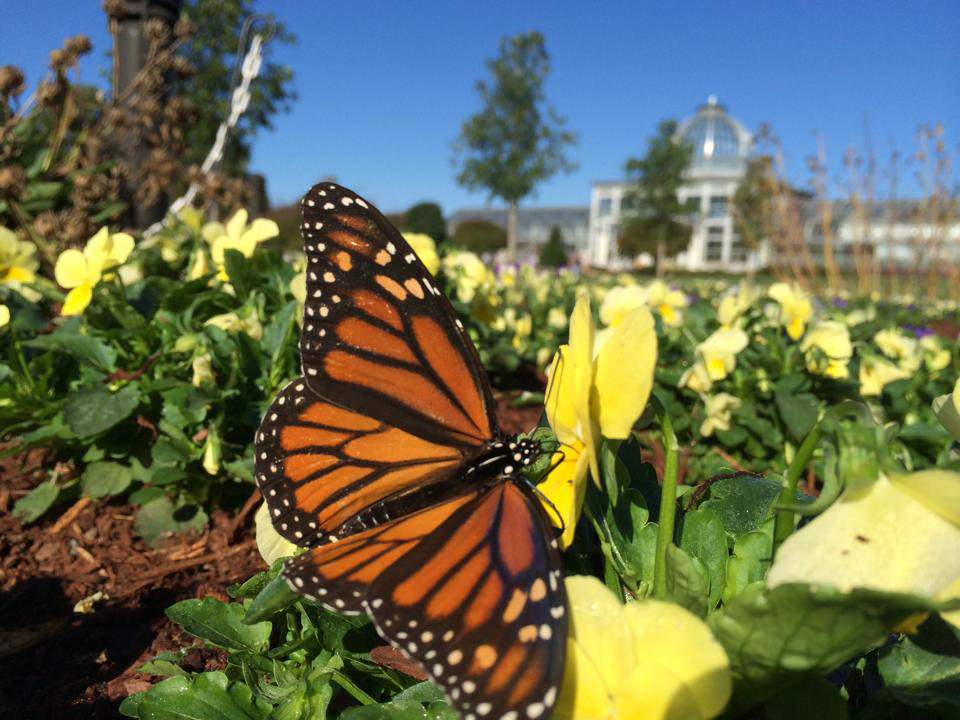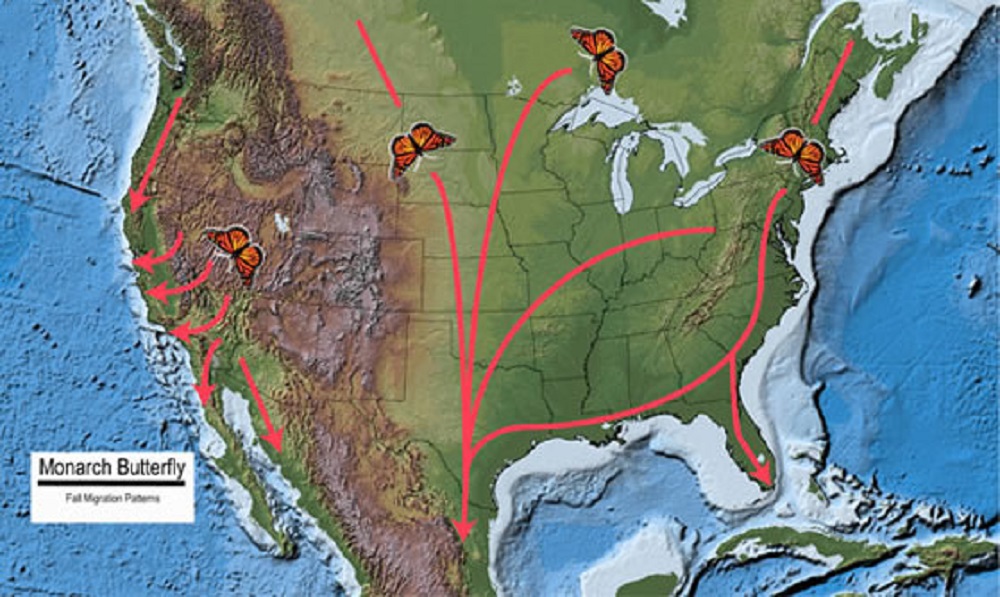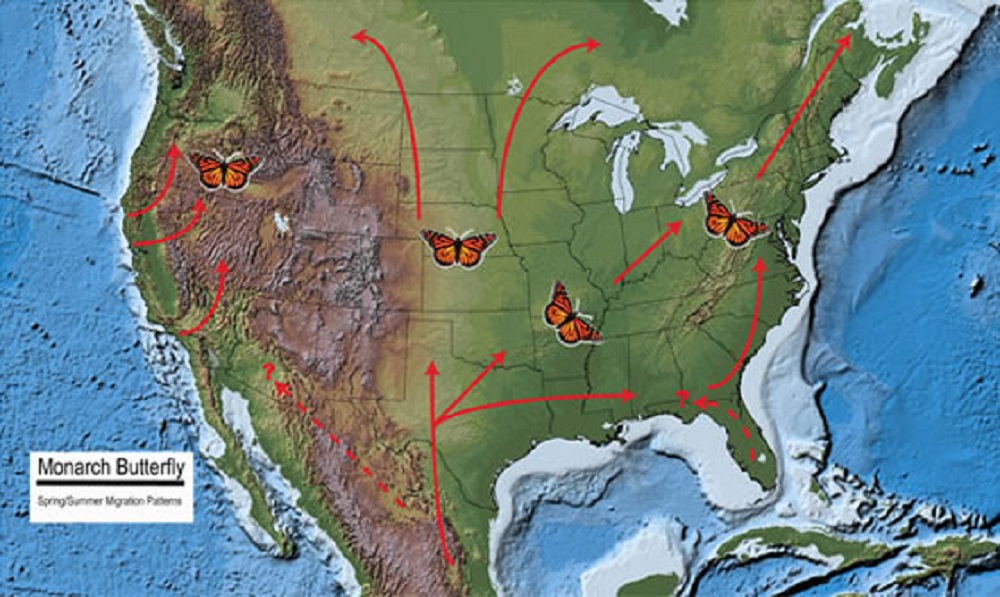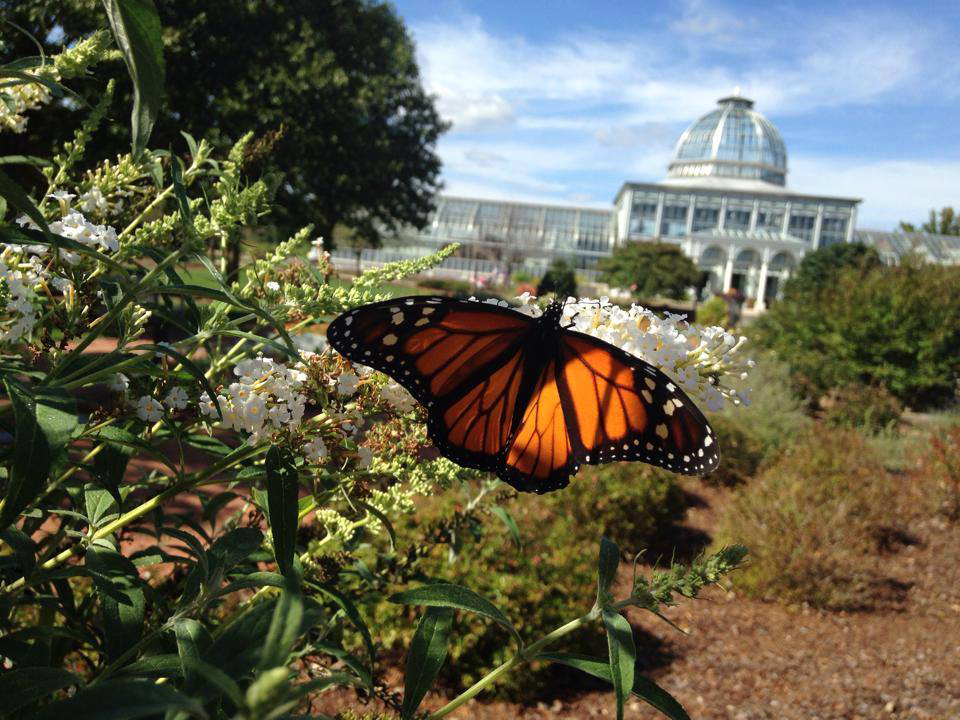Monarch Migration

A monarch butterfly visiting the Central Garden in late fall. The Conservatory is in the background.
It’s that time of year! The monarch (Danaus plexippus) migration is underway as these incredible butterflies begin their journey from as far away as Canada to overwinter in Mexico, coastal California, and the southern tip of Florida. We’ve been seeing plenty of monarchs a the Garden this week since Virginia is on the way for many of them. Some of these butterflies will travel up to 3,000 miles, stopping at various places along the way to rest and drink nectar for the long journey home. Lewis Ginter Botanical Garden typically sees the most monarchs in late summer and fall due to our location. They area attracted to the nectar-filled blossoms and milkweed we have planted here.
How do these delicate insects make this amazing journey?
Who exactly is it that migrates?
The monarchs that returned from last year’s migration are not the same ones that go on the next migration. The average monarch lives only 2-6 weeks, but there’s something special about the monarch that allows them to live long enough to make this migration. In spring, when monarchs return from their winter stay, they start laying eggs in the South as soon as they find milkweed (Asclepias). It’s the next generation that emerges from those eggs as caterpillars and eventually metamorphosed into butterflies will continue the journey north. The monarch will go through four generations from spring to summer. The fourth generation is the super generation. They are the ones that migrate for the winter and they can live up to nine months.
How do they know when to migrate?
According to the University of Minnesota, day length, temperature, and host plant quality are factors that tell the Monarch it’s time to migrate. Insects are cold blooded, so they require an outside heat source (like the sun) to keep them warm. The days getting shorter and the temperatures getting cooler let them know that cold weather is coming and it’s time to go. Another indication is that their host plant, milkweed, begins to die off since it doesn’t grow during the winter. That means that there won’t be any food for their caterpillars, so the monarch’s reproductive organs actually won’t develop until they come back from their winter stay.
How are they able to travel so far and how do they know where they’re going?
Monarchs use a combination of air currents and thermals (pockets of warm air moving upward) to help them fly long distances. According to the U.S. Forest Service, monarchs can travel 50-100 miles per day, taking up to two months to complete their journey. As they travel south, they take frequent stops to rest and drink nectar. How they locate their destinations, though, is still a bit of a mystery. Researchers are looking into it, but they have a theory. They believe it to be a combination of the magnetic pull of the earth and the position of the sun. Either way, it’s fascinating that these butterflies can travel such long distances and end up exactly where they want to be!

The Fall migration route of the monarch heading to its winter destination. Image courtesy of the U.S. Forest Service.
Where do they go to spend the winter?
Most people are aware of the location in Mexico where the monarchs spend the winter. That area was recently in the news because Mexican police shut down several illegal sawmills on the Monarch Reserve. Did you know that there are two other locations where they also overwinter? The majority of the monarchs east of the Rocky Mountains overwinter in the mountains of Central Mexico, while the monarchs west of the Rocky Mountains overwinter in various locations on the coast of California. There’s also a small population of Monarchs from the area around Maine that overwinter in the southern tip of Florida.
What do they do while they’re there?
Monarchs mainly roost and rest while they are in their winter locations. The temperature can get anywhere from 32-60 degrees, so they cluster together in the trees to keep warm. On the way to their winter destinations, the monarchs consistently filled up on nectar. This was not just for energy, but to also build up their stores of fat. While they’re overwintering, so they live off of the lipids stored in their bodies. Once spring arrives they head north again, drinking plenty of nectar along the way.

The spring migration route of the monarch on its way back from its winter destination. Image courtesy of the U.S. Forest Service.
How can you help?
While the monarch caterpillars only eat milkweed, the adult butterflies will drink nectar from any flower. By planting native milkweed and other plants that produce nectar you can create a Monarch Waystation. We have our very own Monarch Waystation here in the Children’s Garden too if you’d like to visit it! Monarch waystations provide monarchs with a food source on their way to their winter destinations as well as a place to lay eggs in spring. If you are unable to plant a garden, you can network with others to protect monarch-friendly habitats and also participate in monitoring the populations by reporting any monarchs you see during their return journey north.
We thought you’d enjoy the video we made this week of a monarch butterfly transformation from caterpillar to chrysalis. It’s always fun to look for monarchs in late summer in your home garden or here at Lewis Ginter Botanical Garden. You might even spot this magical transformation occurring. If you don’t happen to come across any outside, remember we have them inside at our Butterflies LIVE! exhibit too. But hurry, Butterflies LIVE! ends in just a few short weeks, and will be open only through Oct. 9, 2016.
Visit Butterflies LIVE!
Now – Oct. 9, 2016
9 a.m. – 5 p.m. Daily
